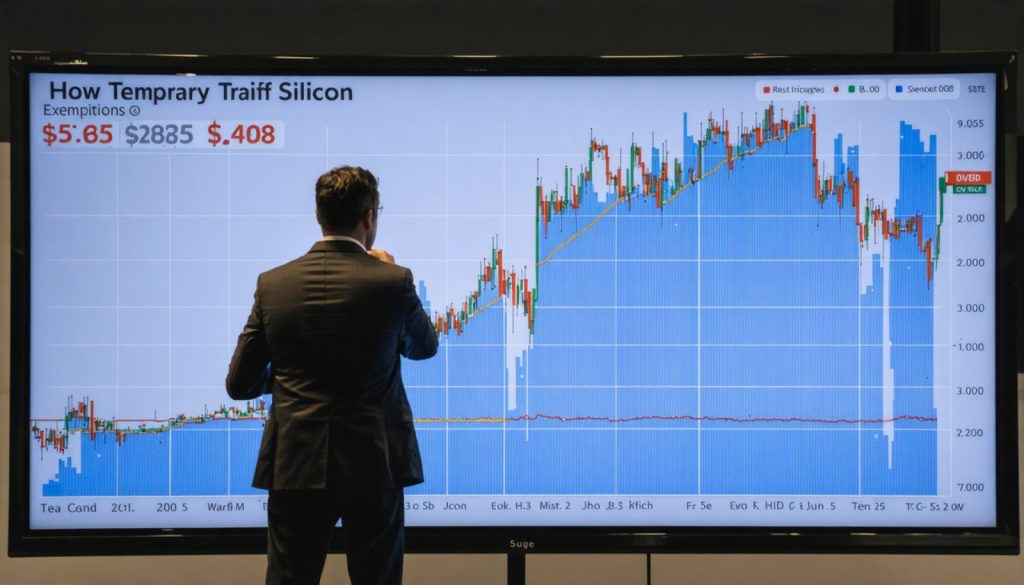
- The Trump administration announced a temporary tariff exemption, positively impacting the tech sector.
- Exemptions cover consumer electronics and computing gear, benefiting key players like Apple, whose stock rose over 3%.
- A wide array of products, totaling $340 billion in global imports (with China contributing $100 billion), are affected.
- The Nasdaq index and companies like Google and Nvidia also experienced market movements.
- These tariff exemptions are seen as a temporary relief amid ongoing trade tensions with China.
- Analysts note a window for potential negotiations, though future tariffs, especially on semiconductors, remain a concern.
- The tech sector remains cautiously optimistic, balancing between temporary gains and uncertain long-term outcomes.
A brisk breeze of optimism stirred the tech sector on Monday as the Trump administration unveiled a surprising, albeit temporary, tariff reprieve that had investors buzzing. The announcement centered on exemptions targeting a suite of consumer electronics and computing gear—products that pulse at the heart of the digital economy. Among the beneficiaries, Apple prominently danced on the trading floor, its stock climbing by over 3% as the afternoon light turned golden on Wall Street.
The scope of these exemptions is vast, spanning a staggering $340 billion in global imports, with China as a significant player, accounting for a whopping $100 billion portion. Analysts quickly recognized the breadth of the products covered: from smartphones and tablets to the intricacies of smartwatches—investors took notice that nearly every gadget bearing the iconic Apple logo was in the technological lifeboat, at least for now.
Not just Apple, but the tech-heavy Nasdaq felt the uplift, nudging itself 0.6% higher. Google’s shares also edged upward, gaining modest ground, while Nvidia saw a fleeting surge before experiencing a slight reversal. Such movements underline the fragile hopes tethered to these exemptions, temporary measures in a landscape marked by a tumultuous trade war narrative.
This unexpected leniency arrives as part of a broader, complex tariff saga that took a sharp turn last Wednesday, when President Trump temporarily hit pause on a broader reciprocal tariff strategy. Yet, the whispers of future tariff impositions—particularly those looming over semiconductors—temper any long-term confidence in these exemptions, casting a shadow of uncertainty.
While President Trump, speaking from the Air Force One, hinted at this temporary measure as a strategic lull before the tariff storm, analysts like Wedbush’s Dan Ives perceived it as cautiously optimistic news. Ives interpreted the weekend’s whirlwind announcements as creating a window for pivotal negotiations with China, a chance to de-escalate the rippling tensions that have so far held the tech industry hostage.
Ultimately, amidst the haze of policy shifts, the tech sector finds itself precariously balanced on the needle-thin edge between triumph and uncertainty. This fleeting pause on tariffs grants a momentary balm, allowing stakeholders to regroup and strategize ahead of forthcoming negotiations. As the world watches this unfolding saga, one takeaway resonates: in the seismic world of global trade, temporary victories require strategic planning to ensure long-term stability.
Temporary Tariff Reprieve Lights Up the Tech Sector: What It Means for Future Trade Relations
The recent announcement by the Trump administration to grant a temporary reprieve from tariffs on a broad spectrum of consumer electronics and computing gear has sent ripples through the tech industry. Here’s a deeper dive into what this development means and where the industry might be headed.
Why Did the Tariff Reprieve Matter So Much?
1. Impact on Major Brands: Companies like Apple benefited immediately from the announcement, with stocks surging over 3%. The reprieve affects products integral to the digital economy, including smartphones, tablets, and smartwatches—items that form the core of Apple’s product line.
2. Scope of Exemption: The reprieve covers $340 billion in global imports, with China contributing $100 billion. This highlights China’s pivotal role in the supply chain for consumer electronics.
3. Effect on Stock Markets: It’s not just Apple that gained; the tech-centered Nasdaq also rose by 0.6%. Companies such as Google and Nvidia experienced fluctuations, underscoring the volatile nature of stock markets in reaction to trade developments.
The Bigger Picture: Trade War Dynamics
– Strategic Pause: Analysts like Dan Ives from Wedbush see this as a strategic pause, providing a window for crucial negotiations with China. The temporary nature of the reprieve suggests continued uncertainty, driving companies to tread cautiously.
– Future Tariff Concerns: While the current exemptions are welcome, the looming threat of tariffs on semiconductors remains a significant concern. This could potentially disrupt the supply chain, impacting not just tech giants but smaller companies reliant on semiconductor imports.
Industry Speculations and Forecast
– Short-Term Relief vs. Long-Term Strategy: This temporary relief is seen as a chance for companies to strategize. Experts recommend utilizing this period to diversify supply chains and seek manufacturing alternatives to mitigate future risks.
– Potential for De-escalation: The reprieve might be an opening for de-escalating tensions between the U.S. and China. Continued dialogue could lead to more sustainable trade relations, though this outcome remains uncertain.
Actionable Recommendations for Stakeholders
1. Diversify Supply Chains: Companies should consider sourcing components from various countries to reduce dependency on Chinese imports.
2. Engage in Advocacy: Businesses can work with trade organizations to influence policy decisions and gain clarity on long-term tariff plans.
3. Invest in Research and Development: By focusing on innovation, companies can create unique products less susceptible to international trade disruptions.
4. Monitor Market Trends: Keeping an eye on geopolitical developments will allow companies to quickly adapt to changes in trade policy.
Conclusion: Navigating the Tariff Landscape
While the temporary tariff reprieve provides a brief moment of relief for the tech industry, it also highlights the need for strategic planning and flexibility in an uncertain trade environment. By taking proactive measures, companies can better position themselves to navigate future challenges.
For more information about the evolving tech and trade landscape, visit Apple or Google.
While enjoying this temporary respite, stakeholders should focus on long-term strategies to mitigate risks and ensure stability in their operations.



